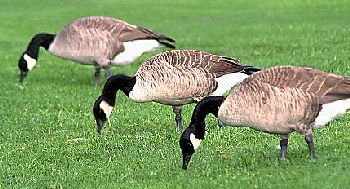February 21, 2013
 02/22/13 If Canada geese have become a problem on your property, information is available through the Indiana Department of Natural Resources website.
02/22/13 If Canada geese have become a problem on your property, information is available through the Indiana Department of Natural Resources website.
Most goose problems occur from March through June, during the nesting season, when geese are especially aggressive, sometimes attacking and nipping at people.
Geese also can cause a great deal of localized damage if many young are hatched in one area. After hatching, goslings are incapable of flight for about 70 days, so the young birds and their parents will graze near the hatching area for that time. Damage to landscaping can be significant and expensive to repair or replace, while large amounts of excrement can render areas unfit for human use.
Information on actions property owners can take to manage Canada geese is available at dnr.IN.gov/dnr/fishwild/2996.htm.
Solutions range from habitat modification, to daily goose harassment through noisemaking devices, to supporting goose hunting or obtaining a DNR trapping permit. The U.S. Fish & Wildlife Service also allows landowners who are properly registered to destroy resident Canada goose eggs and nests on their property.
More information on registering for federal permission to destroy eggs and nests is at https://epermits.fws.gov/ercgr/gesi.aspx. It’s against federal law for anyone to destroy a Canada goose nest that contains one or more eggs without first securing permission through the U.S. Fish & Wildlife Service.
It’s best to use preventive measures such as habitat modification before geese become a nuisance.